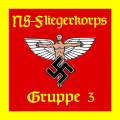Paramilitary organization of the Nazi Party
| Nationalsozialistisches Fliegerkorps - NSFK | |
 NSFK pennant | |
| Agency overview | |
|---|---|
| Formed | 15 April 1937 |
| Preceding agency | |
| Dissolved | 8 May 1945 |
| Jurisdiction | Occupied Europe |
| Agency executives |
|
The National Socialist Flyers Corps (German : Nationalsozialistisches Fliegerkorps; NSFK) was a paramilitary aviation organization of the Nazi Party.





















